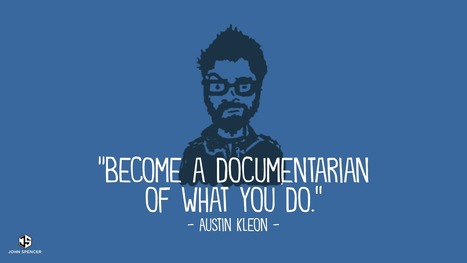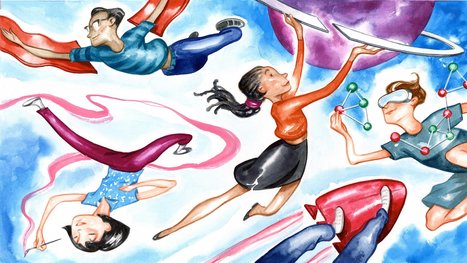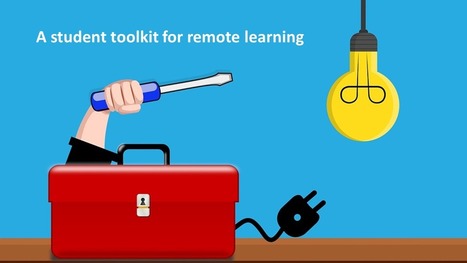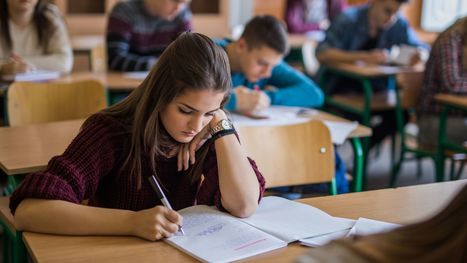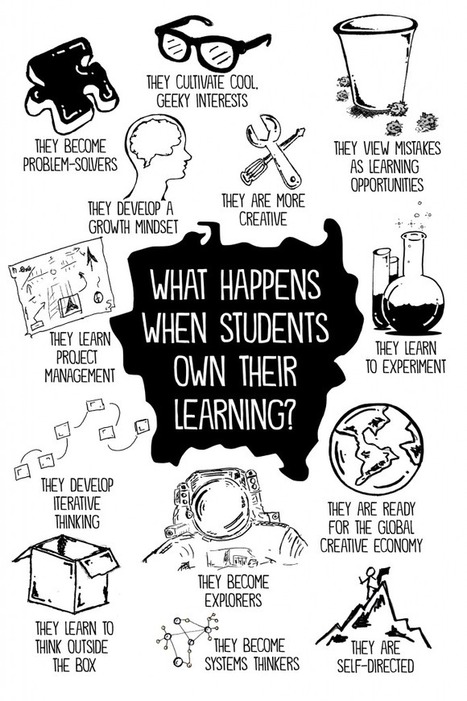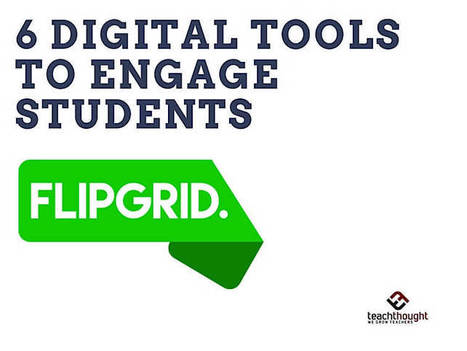 Your new post is loading...
 Your new post is loading...

|
Scooped by
John Evans
|
’ve long used Instagram as a way to reach out to my students. It started back when I first got an iPad through DonorsChoose at my previous library (before I had a personal smartphone). Some of my former students (now adults) still follow that account and keep in touch. When I started at Tampa Prep, I created a new account for the library (@TPrepLibrary) separate from my personal account (@dianalrendina) to help conform to the school’s social media policies.
During the lockdown and virtual learning time in the last quarter of the 2019-2020 school year, the library Instagram account became an essential way for me to keep in touch with my students and share with them. During this time, I also had more time for PD, so I watched several AASL conference sessions on Instagram and took the fantastic eCourse, Dare to Grow: The Instagram Lab (called Grow Your ‘Gram at the time). While that eCourse is geared more towards solopreneurs and not everything applied to the school library, I found SO many actionable tips in this course that I’ve utilized in my school library Instagram account.

|
Scooped by
John Evans
|
For at least a decade now, the driving force behind education reform has been data. We talk about collecting data, analyzing data, and making data-driven decisions. All of this data can certainly be useful, helping us notice patterns we might not have seen without aggregating our numbers in some way, looking for gaps and dips and spikes, allowing us to figure out where we are strong and where we need help. In terms of certain academic behaviors, we can quantify student learning to some extent and improve our practice as a result.
And yet, we know this is not enough. We know our students bring with them so many other kinds of data. So many other factors contribute to academic success: the atmosphere in their homes, the demands of their out-of-school school schedule, the physical concerns that distract them, the passions and obsessions that consume them. These things are much harder to measure, so we don’t even try, focusing instead on the things we can convert to numbers.

|
Scooped by
John Evans
|
When you show your work, you are forced to communicate what you did and how you did it in a way that others understand. It becomes a chance to reflect on your work but also clarify misconceptions and catch any blind spots.
If you look at the entire metacognition cycle mentioned in the video, you’ll notice that the last part of metacognition is the reflection piece. When students are sharing their journey, they are more reflective on their process and better able to plan a new approach in the future.

|
Scooped by
John Evans
|
When Google began Project Oxygen, they assumed the best predictor of employee success would be university program and grades. Instead, the top of their list was, “being a good coach; communicating and listening well; possessing insights into others (including others different values and points of view); having empathy toward and being supportive of one’s colleagues.” In other words, the most critical factors for success involved collaboration. Later, when they studied their teams in Project Aristotle, they found the top skills were, “equality, generosity, curiosity toward the ideas of your teammates, empathy, and emotional intelligence.” Again, these were the soft skills most closely aligned to collaboration.
But how do you actually do this? How do you create projects that boost collaboration in a K-12 environment?

|
Scooped by
John Evans
|
What is the difference between a teacher-centered and learner-driven classroom?
We’ve taken a look at examples of student-centered teaching before. It’s both a subtle (in theory) and dramatic (in function) shift in the entire ecology of a classroom, curriculum, and sense of student identity in the process of learning. This idea isn’t new in and of itself. John Dewey espoused many of these same ideas century ago. It’s an idea that continues to pick up steam with proponents of ‘progressive education.’
Sylvia Duckworth–who has created dozens of useful, minimalist sort of sketch notes/illustrations that convey ideas in education–has taken the thinking from Barbara Bray and Kathleen McClaskey and created a complimentary visual. (In fact, you can go straight to the source and read more from Bray and McClaskey on Choice is More than a Menu of Options.)
What happens when you empower students with choice and purpose? What do the new roles and responsibilities look like? The overview below (from the image above) offers some clarity on what changes. The biggest takeaway might be the change in focus from content delivery to purpose discovery.
I don’t think anyone would argue that all people are the same. Sure we’re made of the same DNA, we all smell, get hungry, angry, laugh and spend most of our lives trying to discover who we are and…
Via Ana Cristina Pratas

|
Scooped by
John Evans
|
A collection of ideas to consider as you work to fuel your students’ curiosity.

|
Scooped by
John Evans
|
"There’s an old saying that the things that change your life are the books you read, the places you go, and the people you meet. But I’d like to add a fourth: the challenges you face (and how you face them) will always change your life. If we want our students to respond to challenges with creativity and inventiveness, we must create the conditions in which innovation is not only possible but encouraged. You don’t help students learn to invent by giving worksheets or cookie-cutter assignments. In fact, these one-size-fits-all approaches may actually take up the time that could be used for such creativity.
Perhaps it is because we focus on students’ weaknesses instead of their strengths. In many schools, we’ll put a math genius who struggles with grammar into extra English classes. Should we not give this math genius access to college-level advanced math work, and figure out the basic English requirements he or she needs for a basic understanding of grammar? Why do we think that all students should be good at everything?
We can either be average at everything or exceptional at something. With this in mind, here are some things we need to do to encourage student inventors as we nurture student passions, interests, and strengths."
|
Introduction This is a guest post written for students by students Matty Trueman, Kai Ackroyd, Curtis Alexis-Jones and Gagan Warinch to highlight the free collaboration tools available and how they can support remote learning. We are final year students at Sheffield Hallam University. Our blog post will look at how you as a student can:…
Via NextLearning

|
Scooped by
John Evans
|
onsistently getting the best work from your students
Typical strategies for getting the best work from students focus on extrinsic motivation and gamification—points, grades, badges, certificates, stars, trophies, glowing feedback, encouragement, pep talks, ‘pressure,’ and other ways to ‘motivate students.’ That these strategies are underwhelming in effect—and tend to not yield the life-long learners education seeks to create—shouldn’t be surprising.
Below, I’ve offered 20 strategies for getting the best work from your students. Some are obvious (provide student choice) and many you may already do. The idea here is to clarify the kinds of teaching practices and learning strategies that give your students the best chance to do their best–to consistently do their very best work, and grow the most as students over the course of a school year.

|
Scooped by
John Evans
|
Putting students in the driver’s seat includes having them assess their writing, which also eases the teacher’s grading load.

|
Scooped by
John Evans
|
Your student activists are going to love WalkWoke.The iPhone app allows for the creative of impactful political posters to print, publish or share with meme-style ease.The app was launched in January by Tangelo, a venture studio and an innovation lab with a diverse team–built and founded by immigrant women.

|
Scooped by
John Evans
|
Take a look at the definition of student-centered learning, and let me know what you think:
Student-centered learning (SCL), or learner-centeredness, is a learning model that places the student (learner) in the center of the learning process. In student-centered learning, students are active participants in their learning; they learn at their own pace and use their own strategies; they are more intrinsically than extrinsically motivated; learning is more individualized than standardized. Student-centered learning develops learning-how-to-learn skills such as problem solving, critical thinking, and reflective thinking. Student-centered learning accounts for and adapts to different learning styles of students (National Center for Research on Teacher Learning, 1999).

|
Scooped by
John Evans
|
Summer vacations - that time of the year that students look forward to the most! The much needed break at the end of each academic year gives students a chance to let their hair down and have fun. With unlimited ice creams, video games, summer camps, and quality time with family, it isn’t hard to see why kids love summer vacations.
But for parents, it is quite a task to keep their active kids engaged and to ensure that there is minimal summer learning loss. While vacation time is all about having fun, there are ways to integrate learning with fun to engage today’s tech-savvy children. Here are 8 apps to ensure a fun learning experience for elementary learners this summer:

|
Scooped by
John Evans
|
Are you looking for some new ways to keep students engaged through the end of the school year?
Here are 6 tools that I have found to be quite helpful as this school year winds down. More importantly, these are also some of the student favorites, in no particular order.
|





 Your new post is loading...
Your new post is loading...



